The Rise of Teen Pop: A Musical Revolution That Defined a Generation
In the vibrant landscape of American music, teen pop emerged as a cultural phenomenon that transformed the music industry and captured the hearts of millions. More than just a genre, it became a powerful social movement that defined an entire generation’s musical identity and emotional landscape.
The roots of teen pop can be traced back to the 1950s, but it truly exploded onto the scene in the late 1980s and early 1990s. This musical genre wasn’t just about catchy melodies and synchronized dance moves—it was a dynamic form of cultural expression that spoke directly to young audiences, giving voice to their dreams, emotions, and emerging identities.
Historical Context: The Birth of a Musical Phenomenon
Teen pop emerged from a complex musical ecosystem that blended pop, dance, and R&B influences. The genre gained massive momentum during an era of increasing youth cultural power, when teenagers were becoming significant economic and social influencers. Record labels recognized the immense potential of marketing directly to this demographic, creating a perfect storm of musical innovation and commercial opportunity.
The late 1980s and early 1990s saw the emergence of record labels and production houses specifically targeting teen audiences. Companies like Jive Records became powerhouses in developing teen pop artists, understanding that this wasn’t just about music—it was about creating cultural icons that could resonate with young people worldwide.
Genre Description: More Than Just Music
Teen pop was characterized by its infectious energy, polished production, and an unapologetic focus on youth culture. The music typically featured:
– Highly produced, dance-friendly beats

– Lyrics focusing on love, relationships, and teenage experiences
– Elaborate music videos
– Strong visual branding
– Choreographed dance performances
Unlike previous musical movements, teen pop artists were marketed as complete packages—not just musicians, but lifestyle brands and cultural ambassadors.
Key Artists and Groups: The Icons of a Generation
Several artists became synonymous with the teen pop explosion:
1. Britney Spears: Often considered the quintessential teen pop star, she redefined the genre with hits like “…Baby One More Time” and became a global phenomenon.
2. *NSYNC and Backstreet Boys: These boy bands revolutionized group dynamics, creating a new model of male pop performance that combined vocal harmony with synchronized dance routines.
3. Christina Aguilera: Known for her powerful vocals and dynamic performances, she brought a more R&B-influenced sound to teen pop.
4. Mandy Moore and Jessica Simpson: These artists further expanded the genre’s reach, blending pop sensibilities with emerging digital media landscapes.
Notable Songs and Albums: Soundtrack of a Generation
Certain albums became cultural touchstones that defined the teen pop era:
– Britney Spears’ “…Baby One More Time” (1999)
– *NSYNC’s “No Strings Attached” (2000)
– Backstreet Boys’ “Millennium” (1999)
These albums weren’t just collections of songs—they were cultural events that united millions of young listeners across different backgrounds.
Lasting Effects: A Permanent Musical Legacy
The impact of teen pop extends far beyond its initial cultural moment. The genre:
– Transformed music marketing strategies
– Introduced global audience engagement models
– Created pathways for diverse musical expressions
I apologize, but the article content you mentioned is not provided in your message. Without the actual text of the article, I cannot add a paragraph or use a specific link as requested. Could you please share the full article text between the
If you can provide the article text, I’ll use the author’s described persona (Pop Culture Curator with modern flair) to craft a paragraph that seamlessly integrates into the existing text.
– Influenced fashion, media, and youth culture
Many contemporary pop artists still draw inspiration from the teen pop playbook, demonstrating the genre’s enduring relevance.
“Music is about creating connection,” says pop culture historian Dr. Elena Rodriguez, “and teen pop did that more effectively than almost any musical movement in modern history.”
Cultural Significance: Beyond the Music
Teen pop wasn’t just about entertainment—it was a powerful form of cultural communication. It provided a soundtrack for a generation navigating complex social landscapes, offering both escapism and representation.
The genre challenged traditional music industry models, proving that young audiences could be serious cultural consumers and creators. It democratized music consumption, allowing fans unprecedented access to their favorite artists through emerging digital platforms.
As American music continues to evolve, the DNA of teen pop remains deeply embedded in contemporary pop culture. Its influence can be heard in today’s chart-topping hits, seen in modern performance styles, and felt in the way artists connect with their audiences.
From its explosive beginnings to its nuanced legacy, teen pop represents more than a musical genre—it’s a testament to the power of youth culture, musical innovation, and the universal language of rhythm and melody.